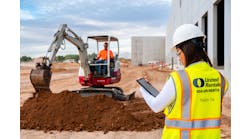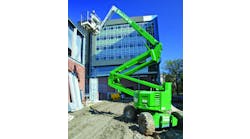Aerial equipment manufacturers continue to innovate in new machine designs and safety initiatives as well in cost containment and green building and operating practices. RER interviewed several of the leading aerial equipment providers to find out how component cost increases, the slowdown in construction and the growing trend toward green building are impacting their sales and engineering efforts.
Participants:
Linda Mayer, vice president and general manager, global marketing and product management, Terex Aerial Work Platforms, Redmond, Wash.
Kirsten Skyba, vice president of global marketing, JLG Industries, McConnellsburg, Pa.
Christophe Debatisse, chief financial officer, Haulotte US, L’Horme, France
Brent Hagedorn, director, marketing and national accounts, Bil-Jax Inc., Archbold, Ohio
RER: All equipment manufacturers are being hit with major cost increases, including steel, tires, components, copper and more. How are you handling these higher costs and are they affecting any of your design/engineering decisions?
Mayer: Like other manufacturers, we are facing unprecedented raw material and commodity cost increase pressures. Impacts are coming from the rising cost of oil, which affects transportation costs (inbound freight and global shipping costs), and dramatically higher costs for steel, fabrications and hydraulics.
These increases are real and we are working hard to mitigate them as much as possible. We are examining all aspects of our business, including cost containment, cost avoidance, improved productivity, and the way we staff and support the organization. Continuous improvement is a part of our culture. Cost reduction efforts will not compromise our design integrity although we naturally prioritize our resources on those projects that are the most impactful in the market. Additionally, we have announced a price increase effective Sept. 1.
Skyba: Certainly that’s a concern for us. We’ve seen steel go up by close to 100 percent in the past few months. Copper and aluminum have increased as well. We’re all in tune daily with what’s happening with oil. What I can tell you is that, with our type of equipment, it’s not as though you would see a migration from one type of material to another. Because if you think about the idea of trading off steel for aluminum, aluminum is almost as effective as steel is, or if you think about trading off a steel engine cover for a plastic one, well, plastics are petroleum based so you’re seeing a cost increase there as well. So we really haven’t done a lot in that respect in terms of our engineering.
One of the things that we have done is take a look at expanding our remanufacturing programs, because what it’s doing is recycling steel. So as those steel prices and other commodity prices continue to increase, you’re putting new life into existing equipment; you get the benefit of whatever price that steel was at a few years ago.
We’ve long been at the forefront of that remanufacturing movement. We’ve really made sure we’ve got the capacity to accommodate our customers in that regard and we see a lot more discussion around that. What we’re also seeing is probably more focus on our electric-powered product lines versus diesel and engine-powered.
As we look to integrating the Tier-4 engines, one of the areas of focus for us is trying to understand if we can accomplish the same work and the same performance with lesser horsepower. That, of course, brings more fuel efficiency to each operation. Obviously we can’t sacrifice performance at any point, but if we can do what we need to do with lesser horsepower it means that the equipment is always going to be more fuel efficient. That is an area of focus for us in the coming years.
Debatisse: We are making decisions on this subject with new suppliers to see if it’s possible to get the same components at a lower price from different parts of the world, and to find equivalent components with the same technical condition that can be use in machines.
Hagedorn: We have been faced with the issue of rising costs. Bil-Jax worked every alternative to keep the costs down for our customers but was ultimately forced to have an increase in pricing.
We have been researching replacement construction materials and designing new products with alternative metals as opposed to our traditional materials. We are, however, committed to the highest-quality products. We will not make rash choices in materials to save costs that may affect the quality of our finished goods.
Do you have plans to develop any hybrid technologies for future models? Are you looking to modify your equipment to be more fuel efficient or to be approved for use with biofuel?
Mayer: We manufacture several products that reduce or eliminate emissions, including scissors and booms utilizing battery power. In addition, we have produced a hybrid-type boom for years. The Z-45/22 Tri-Fuel and Z-45/22 Bi-Fuel were popular in the late 90s. These machines were an early form of parallel hybrid featuring battery power as well as internal combustion power. They were replaced with the currently manufactured series hybrid Z-45/25 Bi-Energy and Z-34/22 Bi-Energy.
Over time we plan to introduce battery-powered/electrical technology to our other machines. Our technology-development team is constantly working to find ways to apply high-performance, battery-powered technology and low-emissions engines in all of our product lines.
We are also working on a fuel-efficiency project to match the engine-speed requirements to the demands of the machine load.
Skyba: We’ve really offered hybrid products since 2000. We’ve got two hybrid scissor models available; we’ve got six hybrid booms that combine electric and battery power. We offer the tallest electric boomlift in the industry. We offer a full product line from 30 to 60 foot in both hybrid and electric, so certainly we see continuing to evolve that product line, but it’s one we’ve been in for a long time.
We’re very proud that we do offer the largest line of environmentally friendly lift equipment. And those offer lower emissions, lower energy consumption, higher efficiency and spill resistance on our electric scissor line. There are four hydraulic points that potentially would be leak points whereas on a typical scissor it’s more than 30 or 40.
Those little things really add up to making for more environmentally friendly products.
Debatisse:Of course we are already working on long-term solutions and on hybrid technologies.
Hagedorn: This certainly is a possibility and there has been discussion, but no final products have been manufactured. We only recently added diesel engines to our trailer-mounted and self-propelled lifts.
What was the motivation behind really concentrating on hybrid manufacturing before it became chic to do so?
Skyba: It has become very chic hasn’t it? I think we’ve really had a focus on environmental stewardship for years. I can go back in our records, and in 1997 we had a Pennsylvania Governor’s Award for environmental excellence because we were striving for zero emissions in certain parts of our manufacturing process.
I think that was reflected in our product line too because one, we saw good applications for electric equipment, but also the benefits that it brought to our customers in terms of efficiency and environmental friendliness. We continue to see that focus on green construction methods. We also saw, and maybe we were a little bit ahead of our time, that that would start affecting the type of equipment used on a construction site. In the end, for us, it really is always about trying to be ahead, but also doing that based on our customer feedback, so a lot of our conversations with our customers led us to believe that we really needed to add that type of product line.
Today we’ve got more than 20 scissors or boomlifts that are, what I would call, hybrid, electric or environmentally friendly. I think we’re seeing more focus on that type of equipment.
All of our diesel engines to some extent or another can use or integrate biofuels — boomlifts, telehandlers — all of them are able to use some level of biofuel, though that percentage varies by engine model.
Are there any other green manufacturing initiatives that your company has implemented or is considering?
Mayer: Green initiatives are already a focus for Terex Aerial Work Platforms (Genie Industries) and we are always searching for new ways to improve our green practices. We use the Washington State environmental laws as a guide for policy even in locations that have less strict regulations.
Genie places an emphasis on recycling in every area of its business. For example: We have operated under an Environmental Management System since 2002. Because of this EMS, Genie can track per-unit use of electricity, water, natural gas, solid wastes, hazardous and industrial waste.
Terex AWP has recycled cardboard, steel and wood for many years, while actively tracking it since 2002. Paper and cardboard are combined and sent to Waste Management for recovery. Wood waste is either directly reused (pallets) or sent to Waste Management for conversion to hog fuel and energy recovery. Steel is sent to a metal recycler and shipped to various steel mills.
In terms of water use, our production facilities have seen steady declines in water use, with increases in production output. Serious considerations were given to water reduction starting in 2001. In 2003, Genie Industries received the Business and Industry Resource Venture’s Water Conservation Award. In 2006, Genie Industries won the Silver Award from the King County Department of Natural Resources and Parks Industrial Waste Program for maintaining compliance with its wastewater permit and continuing to help protect the King County treatment works and water quality of the Puget Sound Region.
As for lighting, we have actively sought the lowest-energy-use lighting fixtures while re-lamping our production facilities.
Toner cartridges are sent out to be re-manufactured. Binders, report covers, section tabs, hanging files and other office supplies have been collected and re-used for many years. This cuts down on the annual demand for new office supplies.
In addition, composting café wastes began on April 22.
Skyba: In terms of green manufacturing initiatives, again, that’s been something we’ve been focused on for a number of years and, I think as your article, and a lot of the conversations we’ve been having indicate, environmental stewardship is becoming a concern not only for the access industry but everybody.
We have a whole matrix of strategic environmental objectives as it relates to our production and our processes, meeting and exceeding regulatory and, what you call societal-compliance expectations, minimizing and preventing any damage to the environment where we’re operating.
We maintain very active regulatory and community relations on the topic of the environment. We put in place what I would call robust sustainability and stewardship principles throughout our processes and that means we work to manage waste. We have waste reduction programs in place in all our facilities.
We have a real focus on energy efficiency and utilization. We’re in the process of developing energy footprints for all of our manufacturing and service facilities. We do things like install automatic lighting management so that you’re not lighting an area when it doesn’t need it.
We’re putting in variable-speed motors in overhead cranes so we’re not always maxing out that engine, but we’re operating at the lowest level of electrical load.
We’ve even hired energy management consultants to work on evaluating our energy usage, so it’s a very comprehensive, holistic program that we have in place, and certainly emissions reduction is also an area where we’ve spent a lot of time. We’ve reformulated paint formulas to reduce emissions. We’ve got water recirculation reuse systems. Things like that really affect how much energy we use, how much waste we generate on a daily basis, and we find all of those little things really add up to make a significant impact.
One of the things I find really exciting is we’ve put together a human resources initiative to pull together an employee green team to take a look at generating any other ideas for what we as a company can do — whether that’s installing large water-bottle coolers for people drinking bottled water, rather than putting that waste into the landfill. Offering opportunities for employees to bring household items in to the plant that need to be recycled if they don’t get it picked up automatically at their homes. The purpose of the green team is to determine ways to get our employees individually more involved.
Debatisse:We are always aware of green manufacturing principles from the beginning of manufacturing to the sale of the machine: including components, paint, recycling waste, hydrocarbons separators and sewage-treatment facilities.
In the context of a real awareness of environmental issues and the tightening of legislation, Haulotte Group is taking steps to control and reduce its environmental impact and is integrating its environmental approach into its global management system.
In order to prepare for this next stage, the Haulotte teams and their partners are already working on the development of devices and processes adapted to more environmentally friendly machines, including particle filters, advanced cooling systems, electronic fuel injection, and better quality and ultra-low sulphured fuel.
In the group’s five European manufacturing plants, measures have been taken that illustrate a commitment to the environment. In the design of buildings a better insulation is used in the roofs, and there is an increase in the number of translucent surfaces increasing natural light and decreasing electricity and energy consumption.
Internal processing waste is pushed to the maximum: recycling waste, hydrocarbons separators and sewage treatment facilities.
Finally, Haulotte Group pays special attention to the products present in its plants, and to the way they are used: for several years, lead-containing paint has not been used, and dry-extract paintings are favored, allowing a significant decrease of volatile organic compounds. And on several sites powder paints are used, which have zero VOC emissions. Hydraulic oil is distributed using pipelines in order to reduce storage areas and the number of stored barrels.
And to reaffirm its commitment to control the impact of its activities on the environment, the Haulotte Group is working towards obtaining ISO 1400 certification.
Hagedorn: Bil-Jax has recently committed itself to a green initiative. This includes the creation of a committee to investigate and implement a variety of initiatives designed to reduce the environmental impact of the company’s manufacturing practices and day-to-day operations.
Bil-Jax Go Green has been active for just over a month. In its first month, Bil-Jax employees recycled 3.67 tons of material. This includes 1.34 tons of paper, 1.04 tons of wooden pallets, 0.40 tons of plastic bottles and more.
Bil-Jax has partnered with a local recycling center, Werlor Inc., to help identify waste materials and recycle them instead of sending them to landfills.
Progress and current information can be found online at Bil-Jax Go Green’s website www.biljaxgogreen.com.
I’ve noticed some talk of moving to solid rubber tires and away from foam-filled and standard pneumatic tires as a way to reduce downtime, increase productivity and reduce waste. What are your thoughts on the topic?
Mayer: We recently introduced off-road semi-pneumatic tires for the GTH-5519 compact telehandler models. The tires provide customers further options to the current air and foam tires, offering overall improved performance and a lowered cost of ownership.
Semi-pneumatic tire technology offers many benefits, including engineered side walls that are resistant to cuts and snags in severe cutting conditions that would normally destroy a typical foam-filled tire. With its deeper directional tread and heavy-duty rubber, this design lasts up to three-times longer than foam-filled tires lowering cost of ownership, including recycling costs.
Semi-pneumatic tires offer exceptional off-road performance for improved terrainability. Due to their deep-lug self-cleaning tread design, traction effort is improved in dirt, snow, sand and deep mud over standard rough-terrain tires. The resilient pneumatic-type ride also absorbs shocks from rocks and rough terrain. The design offers the durability of a solid tire, but with the smooth, cushioned ride similar to that of a pneumatic tire.
Skyba: We absolutely believe they can have a positive environmental impact and not only that, but there are also financial benefits to our customers for using them. We offer solid tires on almost every product that we build. I believe in most cases they’re optional for people who elect to use them.
In the case of RSC, we partnered with them to make solid tires standard on all of the telehandlers that they’re buying from us. We see more and more of our customers going to solid tires as standard. It reduces the likelihood of downtime because you’re not dealing with flats, but it also increases reliability. It saves costs over the life of the tire because you’re looking at probably four times the useful life. And then because they’ve got that longer lifespan, you just reduce the number of tires going to the landfill. Using solid tires literally cuts landfill waste by 75 percent, making a pretty substantive impact.
Debatisse: We are doing the same test with tires for different countries. We are waiting for the technical answer to make a final decision whether to sell machines like this.
Hagedorn: The only products we offer foam-filled tires on are our new X-Boom line. The X-Boom is a lighter-weight self-propelled lift that utilizes hydraulic outriggers as opposed to a heavy counterweight, as found on traditional self-propelled lifts. This makes it possible to use an X-Boom on pressure-sensitive applications, such as a gymnasium floor or on a beach. Foam-filled, because of their lighter weight over solid rubber tires, allows for adequate traction in this application.
Standard road tires and bar lug tires are used unless specified otherwise.
Are there any new design trends in aerial equipment or new attachments or accessories?
Mayer: The Terex Aerial Work Platform division continuously evaluates its equipment and designs based on its customers’ needs and perspectives. We also believe strongly in the opportunity to develop new and innovative solutions to address the requirements of the end-users who operate our equipment. Although we can’t talk specifically about concepts that are on the drawing table, we are investing in research and development that will ensure we offer the most up-to-date, reliable and productive equipment for the market.
Skyba: There is more focus on electric and hybrid equipment. We continue to see that being the case. A renewed focus for JLG, and something that’s always been important, is creating longer lifecycles for our equipment. Because when you do that, obviously, your equipment lives longer, which means more value to the customer, and it also reduces the waste of that actual equipment.
And we are seeing a trend in the interest of remanufacturing for all the reasons we talked about. Basically, you’re getting the cost benefits of recycling existing steel, you’re seeing a longer lifecycle for the product where people can put it back in their fleet and get another 5 or 6 years of life out of it, maybe even more, and you’re saving the energy that it would take to produce a new one, as well as the materials. Unfortunately, I can’t quite quantify that, but it’s an area that we are working on to quantify for people.
A good value for rental companies and users, like with any product that uses gas or diesel, is to focus on maximizing fuel economy.
I know you’re familiar with the fact that we’ve been developing our own telematics or connected asset technology. We see that being a pretty big factor in the industry and, frankly, as it plays into the issue of environmental topics, the idea that you’d be able to save unnecessary trips to the field without knowing what the problem is. That has a substantive impact on fuel cost, service cost, and again has an environmental benefit as well.
One of the areas of focus for us on that system was really providing highly customized, highly useful equipment information very specific to AWPs and rental, so the type of information could influence being able to know that the engine information you’re getting is not just based on standard operating hours, but it gives you specific information on that engine and that operating environment.
When you get a maintenance alert, it’s specific to that engine it’s not just some standard, pre-programmed algorithm. That helps improve the efficiency of the use of the equipment and efficiency of the service operation, and saves you trips to the field. I think it’s definitely got an environmental tie-in as well as general productivity and lowering operating costs.
Debatisse:Yes, we are always working to introduce new designs on our products.
Hagedorn: At least for Bil-Jax, the accessory/option that is one of the most desired is our DC/Gas Hybrid option. This allows our Summit Series lifts, and X-Boom lifts to run on battery power or an engine. This is very useful for indoor applications as there is no concern about fumes in an enclosed area.
Have you implemented any new safety initiatives?
Mayer: Safety is a top priority throughout our organization. In 2007 we began focusing on behavior-based safety and ergonomics to complement our existing health and safety programs and are pleased with the results we are seeing. We set aggressive safety and health targets and strive to significantly improve it each year. Our long-term vision is to create a work environment that continuously improves the health and well-being of our team members.
In addition to our in-house safety efforts, Genie continues to be a leader in product safety and the promotion of operator safety. Our engineering staff is actively involved in standards writing and compliance as well as pursuit of continuous improvement of our equipment.
Skyba: That’s something that’s always in our eyes and that we keep in mind in everything that we’re doing on a new product development project. We’re starting to put training programs online to make them even more accessible for our customers.
Hagedorn: Bil-Jax has always been very committed to safety. We are continually looking for ways to not only streamline manufacturing and workflow, but for ways to make it as safe as possible.
Is there a cost associated with the online programs?
Skyba: We’re just starting to get into it so, honestly, I don’t have any cost information for you on that, but the idea that safety and operating training is more readily available, is an important topic for the industry in general. Anything we can do to facilitate that and allow more people to go through those types of programs is really important. These days, it gets back to the whole environmental thing too, as well as cost containment — not having someone travel for two days to do a one-day training course is really beneficial.
The smaller the company, the more you want to leverage what other companies are doing and not recreate the wheel.
Debatisse: We develop safety training in the U.S. every time we design a machine. We also develop safety devices.
Are you adding work platforms to your telehandler line? Explain why or why not.
Mayer: Currently, Genie telehandlers are not retrofitted with work platforms in North America, however, our telehandler engineers and product experts continually explore new avenues and options to safely enhance productivity for all classes of Genie telehandlers.
Skyba: Work platforms are already available and they have been for years.
Debatisse: Yes we are adding work platforms to our telehandlers, both standard and rotating, because our customers request this option.
How has the downturn in the housing market affected your sales and marketing initiatives?
Mayer: Terex AWP is investing in the necessary capacity to meet the demands of our customers on a global basis. Part of our annual planning process is to match our manufacturing capabilities with the demands of the market. We’ve worked hard to stay competitive and innovative, while maintaining our reputation as a customer-first business. Our relationships are what matter and they continue to be our strength.
There is continued demand in the lift market in infrastructure construction, maintenance and repair applications. There is a direct correlation between improvements and growth in infrastructure and demand for lift products. Although residential construction is clearly declining, we are seeing opportunities elsewhere that offer growth potential for the rental companies. Our efforts are focused on balancing the decline in residential construction demand with the areas of strength in the economy. The decline in residential construction really only has a measurable impact on the telehandler segment of our business. Overall, our sales and marketing efforts have focused on the areas of growth.
Skyba: Certainly it’s affected us, particularly in telehandlers. We’ve seen a fall-off in that market because they tend to be used in residential construction. It’s a tough market, but like anything else we’re working through it. One of the things unfortunately that we did need to do is have a workforce downsizing in response to the market conditions that we’re seeing. It’s not just in North America, it’s also Europe is starting to catch some of that flu. We’re working to manage through it, really containing our costs and making sure we stay close to our customers, and that we’re giving them everything they need including financing, which can be helpful in making sure they’re able to update their fleet. We’re going to keep working through it.
Debatisse: We are less affected than our competitors by the downturn in the housing market because our size in the U.S. makes us less vulnerable to its market.
Hagedorn: We have been forced to redirect some of our focus from independent rental locations to larger-scale and industrial-focused operations.





